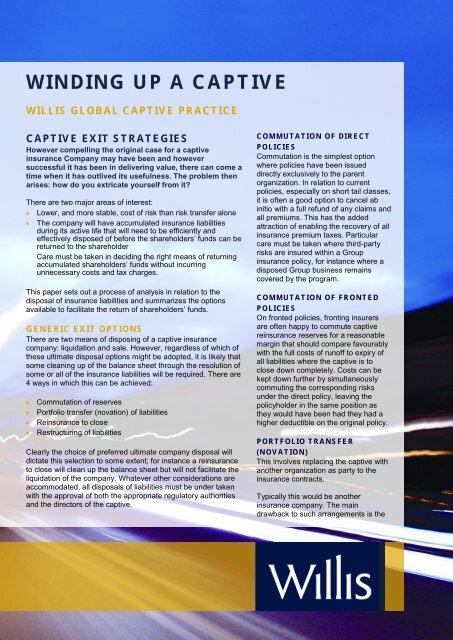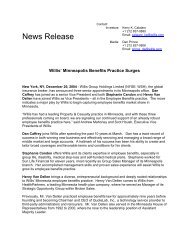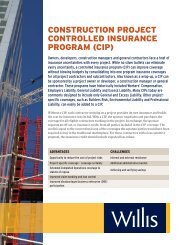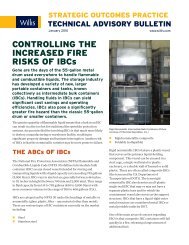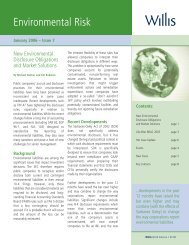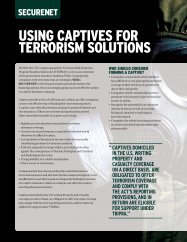WINDING UP A CAPTIVE - Willis
WINDING UP A CAPTIVE - Willis
WINDING UP A CAPTIVE - Willis
Create successful ePaper yourself
Turn your PDF publications into a flip-book with our unique Google optimized e-Paper software.
<strong>WINDING</strong> <strong>UP</strong> A <strong>CAPTIVE</strong><br />
WILLIS GLOBAL <strong>CAPTIVE</strong> PRACTICE<br />
<strong>CAPTIVE</strong> EXIT STRATEGIES<br />
However compelling the original case for a captive<br />
insurance Company may have been and however<br />
successful it has been in delivering value, there can come a<br />
time when it has outlived its usefulness. The problem then<br />
arises: how do you extricate yourself from it<br />
There are two major areas of interest:<br />
• Lower, and more stable, cost of risk than risk transfer alone<br />
• The company will have accumulated insurance liabilities<br />
during its active life that will need to be efficiently and<br />
effectively disposed of before the shareholders’ funds can be<br />
returned to the shareholder<br />
Care must be taken in deciding the right means of returning<br />
accumulated shareholders’ funds without incurring<br />
unnecessary costs and tax charges.<br />
This paper sets out a process of analysis in relation to the<br />
disposal of insurance liabilities and summarizes the options<br />
available to facilitate the return of shareholders’ funds.<br />
GENERIC EXIT OPTIONS<br />
There are two means of disposing of a captive insurance<br />
company: liquidation and sale. However, regardless of which of<br />
these ultimate disposal options might be adopted, it is likely that<br />
some cleaning up of the balance sheet through the resolution of<br />
some or all of the insurance liabilities will be required. There are<br />
4 ways in which this can be achieved:<br />
• Commutation of reserves<br />
• Portfolio transfer (novation) of liabilities<br />
• Reinsurance to close<br />
• Restructuring of liabilities<br />
Clearly the choice of preferred ultimate company disposal will<br />
dictate this selection to some extent; for instance a reinsurance<br />
to close will clean up the balance sheet but will not facilitate the<br />
liquidation of the company. Whatever other considerations are<br />
accommodated, all disposals of liabilities must be under taken<br />
with the approval of both the appropriate regulatory authorities<br />
and the directors of the captive.<br />
COMMUTATION OF DIRECT<br />
POLICIES<br />
Commutation is the simplest option<br />
where policies have been issued<br />
directly exclusively to the parent<br />
organization. In relation to current<br />
policies, especially on short tail classes,<br />
it is often a good option to cancel ab<br />
initio with a full refund of any claims and<br />
all premiums. This has the added<br />
attraction of enabling the recovery of all<br />
insurance premium taxes. Particular<br />
care must be taken where third-party<br />
risks are insured within a Group<br />
insurance policy, for instance where a<br />
disposed Group business remains<br />
covered by the program.<br />
COMMUTATION OF FRONTED<br />
POLICIES<br />
On fronted policies, fronting insurers<br />
are often happy to commute captive<br />
reinsurance reserves for a reasonable<br />
margin that should compare favourably<br />
with the full costs of runoff to expiry of<br />
all liabilities where the captive is to<br />
close down completely. Costs can be<br />
kept down further by simultaneously<br />
commuting the corresponding risks<br />
under the direct policy, leaving the<br />
policyholder in the same position as<br />
they would have been had they had a<br />
higher deductible on the original policy.<br />
PORTFOLIO TRANSFER<br />
(NOVATION)<br />
This involves replacing the captive with<br />
another organization as party to the<br />
insurance contracts.<br />
Typically this would be another<br />
insurance company. The main<br />
drawback to such arrangements is the
However, where risk transfer is required, or the fronting insurer<br />
is unwilling or unable to commute, this can be an effective<br />
solution. Of course, as a risk transfer option costs are likely to<br />
be relatively high and market capacity may be hard to find.<br />
Typically reserves of at least $10 million would need to be<br />
involved for this option to be worth considering.<br />
REINSURANCE TO CLOSE<br />
This involves purchasing reinsurance of the existing captive to<br />
take on or cap existing liabilities. This has the effect of limiting<br />
the downside of the liabilities, but does not mitigate future costs<br />
as the captive will need to remain active during the run off of<br />
liabilities. However, it may be useful where other options are not<br />
available and returning risks to the ultimate policy holder is not<br />
feasible or desirable (for instance where a captive is included in<br />
the disposal of a subsidiary or insurance must be maintained to<br />
meet bankers’ warranties etc.). The implications of running off to<br />
expiry should be carefully considered before committing to<br />
options that involve this as it can take many years before the<br />
captive may close, if indeed it ever does, and management<br />
costs will need to be met throughout that period.<br />
RESTRUCTURING OF LIABILITIES<br />
Typically this involves the novation of liabilities into a PCC cell,<br />
financed through a combination of reinsurance and non-cash<br />
capital. This has five potential advantages over conventional<br />
run-off:<br />
• Opportunity for earlier release of captive capital<br />
• Reduced operational costs and management commitment<br />
• Increased capital efficiency<br />
• Segregation and capping of liabilities<br />
• Improved fiscal efficiency<br />
As with all novation options, the agreement of fronting insurers<br />
will be required to implement such a restructuring.<br />
Disadvantages include a number of<br />
factors that impact one or more of the<br />
costs, difficulty and timescales to<br />
complete a sale. However, there are<br />
additional potential disadvantages<br />
arising out of the inevitable divergence<br />
of the interests of the new captive<br />
owners and the policyholders.<br />
Disadvantages include:<br />
• Loss of control over claims process.<br />
• Loss of security following reduction<br />
of capitalization to minimum levels<br />
• Possibility of the compromising of<br />
commercial interests by the new<br />
owners of the captive acting to bring<br />
about the early resolution of the<br />
insurance business<br />
• Need to persuade counter-parties<br />
and other interests to agree to the<br />
change in ownership (i.e. fronting<br />
insurers, reinsurers, regulators,<br />
policyholders etc.).<br />
• Significant management time<br />
commitment<br />
• Given the need to offer potential<br />
buyers the prospect of profits, it is<br />
unlikely that full value will be<br />
obtained by the captive owner<br />
Given all of the above, it is no surprise<br />
that captive sales are rare and<br />
generally feature in circumstances of<br />
parental distress or where the captive is<br />
a substantial business in its own right.<br />
SALE OF THE <strong>CAPTIVE</strong><br />
Although offering a number of possible benefits, the sale<br />
process itself can be complex and expensive and buyers are not<br />
always easy to find. The key potential advantages include:<br />
• Involves realization of a capital gain rather than the<br />
realization of taxable profits<br />
• Can provide complete and unambiguous finality
<strong>WINDING</strong> <strong>UP</strong> PROCESS<br />
<strong>Willis</strong>’s process towards release of shareholders’ funds<br />
comprises 4 steps.<br />
STEP 1: ANALYZE THE BUSINESS<br />
The nature of the business of the captive will determine the<br />
options available in winding it up. Key in defining the exit<br />
strategy options available are these four questions:<br />
• What are the risks insured or reinsured into the captive<br />
• What program structures were involved I.e. was it written<br />
on a direct or fronted basis, was the aggregate exposure<br />
limited within inward policies or by way of reinsurance<br />
purchased etc.<br />
• What insurance liabilities remain<br />
• What is the best estimate of the quantum and timing of the<br />
remaining liabilities, and associated management costs<br />
• What feasible options exist to dispose of the remaining<br />
liabilities<br />
STEP 2: ANALYZE LEGITIMATE INTERESTS<br />
AND DETERMINE OUTCOME PRIORITIES<br />
The priorities of interested parties and their level of influence<br />
over planning and implementation of the strategy will determine<br />
the selection of strategies from amongst available options. This<br />
involves answering the following questions:<br />
• What are the priorities of the parent in terms of time scales,<br />
costs and desired outcomes<br />
• What program delivery structures were used<br />
• What third party policy holders exist<br />
• What regulatory bodies need to be appeased<br />
• What other legitimate interested parties can be identified<br />
For each party involved:<br />
• What are their priorities<br />
• How can they influence planning/implementation to enforce<br />
their priorities<br />
STEP 3: ANALYZE OTHER<br />
RELEVANT ENVIRONMENTAL/<br />
BUSINESS ISSUES<br />
In the course of business the captive<br />
will have established relationships and<br />
infrastructure necessary for the<br />
execution of its business plan. These<br />
need to be carefully and sensitively<br />
dismantled with minimum cost and<br />
without adversely affecting continuing<br />
business relationships of the parent<br />
organization. Relevant questions here<br />
would be:<br />
• What security is in place in support<br />
of fronted programs<br />
• Does the captive have any directly<br />
employed staff<br />
• What continuing relationship does<br />
the parent organization have with<br />
the service providers and other<br />
counterparties of the captive<br />
• What are the financial and fiscal<br />
objectives of the winding up<br />
STEP 4: DETERMINE A<br />
DETAILED<br />
IMPLEMENTATION PLAN<br />
For most mature captives the legacy<br />
liabilities will be complex, requiring<br />
more than one disposal strategy to be<br />
adopted. As a general rule people tend<br />
to focus on the “low lying fruit” at first<br />
and leave more difficult liabilities until<br />
later. This has the effect of extending<br />
the time line for completion of the<br />
winding up, as well as potentially<br />
limiting options available in relation to<br />
the more challenging liabilities. The<br />
construction of a detailed plan at the<br />
outset helps clarify objectives and<br />
control activity to ensure the quickest<br />
and most efficient exit is achieved.
WILLIS’ CREDIBILITY<br />
<strong>Willis</strong>’ Global Captive Practice is a team of captive insurance<br />
professionals with a wide range of professional backgrounds<br />
and business experience. We are experienced in the challenges<br />
involved in winding up captive insurance companies and have<br />
access to important complementary expertise elsewhere within<br />
the Group, including Structured Solutions, Loss Portfolio<br />
Transfer technology, specialist reinsurance markets etc. We aim<br />
to bring together the expertise and experience from across the<br />
Captive Practice and the Group to design and implement<br />
effective exit strategies that meet your strategic objectives and<br />
required timescales and deliver maximum value to stakeholders.<br />
CONTACTS<br />
WILLIS GLOBAL <strong>CAPTIVE</strong><br />
PRACTICE<br />
For more information please contact:<br />
Asia Pacific<br />
Peter J. Lowe<br />
Chief Executive Officer, New Zealand<br />
Tel: +64 9 356 9368<br />
Mob: +64 21 909 148<br />
Email: peter.j.lowe@willis.com<br />
Europe & ROW<br />
Dominic Wheatley<br />
Chief Marketing Officer, International<br />
Tel: +44 1481 735 630<br />
Mob: +44 7781 135 630<br />
Email: dominic.wheatley@willis.com<br />
North America<br />
Sean B. Rider<br />
Managing Director – Sales and Consulting<br />
Tel: +1 212 915 7865<br />
Mob: +1 646 645 5374<br />
Email: sean.b.rider@willis.com<br />
www.willis.com<br />
www.williscaptives.com<br />
<strong>Willis</strong> Limited. Registered number: 181116 England and Wales. Registered address: 51 Lime Street, London EC3M 7DQ. A Lloyd’s<br />
Broker. Authorised and regulated by the Financial Conduct Authority. 06/2013


